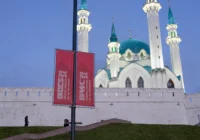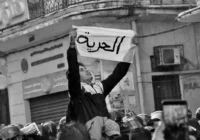Libyan weapons have further militarized movements in Africa.
The 2011 fall of Libyan leader Muammar al-Qaddafi and the subsequent breakdown in order in Libya, has been a major contributor to the instability plaguing large swaths of the Sahel region and Northwest Africa. In particular, the flow of weapons, such as a multitude of small arms and light weapons (SALW) and explosives, from liberated Libyan military stockpiles into the surrounding countries has galvanized existing political opposition currents, separatist movements, and transnational militant groups.
Much of the concern regarding the impact of weapons proliferation out of Libya emphasizes the potential threat of man-portable air defense systems (MANPADS) falling into the hands of radical Islamist militant groups, such as al-Qaeda or one of its regional or international affiliates. In light of the persistent threat of international terrorism as it relates to commercial air travel, such concerns remain valid. Yet it has been the residual impact of the proliferation of SALW and explosives on regional stability and security, that has posed the most immediate threats to what is an already precarious political and security environment.
Mali, which has experienced severe unrest since January 2012 – including ethnic Tuareg-led insurrections, radical Islamist insurgency, and a military-led coup d’état – has been the most dramatic example of the region’s post-Qaddafi volatility; Chad and Niger have also been forced to deal with fallout from the Libyan revolt. Algeria has experienced a noticeable uptick of violence, including the January 2013 attack against the Tigantourine natural gas facility in Amenas in eastern Algeria along the Algerian-Libyan border. The attack at Amenas was orchestrated by militants associated with an offshoot of al-Qaeda’s North African affiliate, al-Qaeda in the Islamic Maghreb (AQIM), known as al-Mulathameen (The Masked Ones). Nigeria believes that radical Islamist militants affiliated with Boko Haram have also been emboldened by their access to Libyan arms. While lying outside of the geographic space that is the subject of this analysis, the increase in violence in Egypt’s Sinai region is also being partially attributed to the influx of smuggled Libyan arms into Egyptian territory.
To date, the proliferation of Libyan weapons has further militarized numerous existing political opposition and radical movements and afforded opportunities for other violent and irregular actors to pursue their own objectives. Qaddafi’s fall was followed by a troubled political transition that remains marred by violence between rival factions and militias, resulting in a power vacuum in one of the region’s most militarized states. As Libya struggles to consolidate its domestic political institutions and establish some semblance of law and order, SALW and explosives proliferation stemming from within its borders will continue unabated. Consequently, the countries lying within the Sahel and Northwest Africa will continue to have their security undermined by developments in Libya.
Libyan Weapons: Galvanizing Violence
Despite the concerns surrounding the disposition of Libya’s arsenal of MANPADS, there is no concrete evidence that any militants present in the region – radical Islamist or otherwise – have procured the weapons systems. Nevertheless, the potential threats associated with MANPADS continue to attract much of the attention in regards to proliferation. These worries were exacerbated by documents discovered in Libya in September 2011, indicating that Russia had provided Qaddafi with several hundred advanced – and unaccounted for – SA-24 “Grinch” surface-to-air missiles. In March 2011, Chad’s President Idriss Deby claimed that Libyan MANPADS had entered Chad and Niger. Malian officials echoed Deby’s claims. A number of unconfirmed reports circulated in regional media outlets claimed that various North African regional militant groups had acquired MANPADS in 2012 and 2013. Algerian officials reported in February 2013 that they confiscated numerous Russian surface-to-air missile systems in Algeria’s southern regions.
But it is the proliferation of more prosaic weapons systems – essentially a diverse array of SALW and explosives – that have most actively contributed to the recent wave of unrest and instability in the Sahel and Northwest Africa. An assortment of Libyan weapons started entering neighboring countries soon after the outbreak of civil war in Libya. In early 2011, assault rifles, ammunition, mortars, mines, and plastic explosives began crossing Libya’s borders into Algeria, Egypt, Niger, and Mali. In April 2011, regional media reports claimed that pickup trucks carrying arms, ammunition, and explosives from eastern Libya had crossed into Mali via Chad and Niger.
Since 2011, concerned officials have repeatedly claimed that Libyan weapons and stockpiles of plastic explosives are being distributed to militants in Niger, Algeria, Nigeria, and elsewhere. Established organized criminal and illicit trafficking networks traversing the Sahel’s ancient East-West trade routes, and associated networks that link the north to the south, are facilitating this trend. The porous borders throughout the territories in question also help ensure that the relative free flow of illicit trade continues unimpeded. The increasing availability of arms has also provided aspiring militants with the opportunity to establish their own fringe factions. Weapons traffickers are also benefiting from the additional sources of supply and increasingly diverse selections of arms.
Mali, Chad, and Niger
This is most evident in Mali. The political leadership in Bamako has long disenfranchised Mali’s Tuaregs, a nomadic population that is related to the indigenous Berber peoples of North Africa and the Sahel region. Qaddafi employed thousands of Tuareg mercenaries from Mail, Niger, and Chad to bolster the Libyan military while fortifying his own power base within the Libyan security apparatus. Following the collapse of his regime, the repatriation of these generally well trained, heavily armed, often battle hardened, and politicized Tuaregs remains a major challenge. In January 2012, a separatist Tuareg rebellion broke out in northern Mali. In March 2012, Malian military officers launched a coup against the government of President Amadou Toumani, in response to what they claimed was the mismanagement of the military with the rebellion. By April 2012, Tuareg rebels, allied with a variety of Islamist militants, had gained control of most of northern Mali, prompting a joint French-Malian military campaign to recapture the north in January 2013.
Despite French and Malian efforts, northern Mali remains a militant stronghold. Tuareg separatist groups such as the National Movement for the Liberation of Azawad (MNLA), the Arab Movement of Azawad (MAA), and the Islamic Movement of Azawad (MIA) exist alongside – and increasingly clash with – regional Islamist extremist groups such as AQIM, the AQIM-affiliated Movement of Jihad and Oneness in West Africa (MUJAO), Ansar al-Dine (AAD), among others. For instance, MIA is a splinter group of AAD. The MIA broke from AAD in January 2013 and subsequently renounced its tactics and ties to AQIM. Similarly, MAA was formed as a secular alternative to the more Islamist-oriented MNLA. These groups – all of whom have benefitted from the influx of weapons from liberated Libyan caches – have created an atmosphere of ongoing violence in Mali, complicating the region’s prospects for stability.
The specter of anti-government violence also haunts Chad. The Union of Resistance Forces (UFR) threatened in March to renew its militant campaign against the Deby regime despite having agreed to lay down its arms in 2010. There has been speculation that arms from Libya have encouraged the UFR’s saber rattling, and Deby – who has survived multiple coups, including an alleged attempt by two generals and two legislators to take over the country this past May – has accused Libya of harboring UFR rebels.
Niger also faces an uncertain future in the wake of the Libyan collapse. In May, MUJAO militants launched a suicide bombing – the first attack of its kind in Niger – against a Nigerien army base and French uranium mine operated by Areva in northern Niger. The group claimed that the operation was designed to punish Niamey for deploying a contingent of peacekeepers to Mali. The attacks, which Niger claimed were launched from Libya, raised concerns in both Niger and Europe about the safety of Niger’s uranium deposits; France, which derives the majority of its electricity from nuclear power, receives about 40 percent of its uranium from Niger. Niger is also reported to possess significant oil deposits, and has a history of rebel-led violence directed at its uranium and oil sector. Since 2007, the Tuareg-based Niger Movement for Justice (MNJ) has threatened to attack oil and uranium operations in the country, unless Niamey provides the MNJ with a greater share of national energy revenues. MNJ has kidnapped Chinese and French workers at oil and uranium facilities, and many fear that the instability in Libya will provide the MNJ with additional resources and an increased operational capacity.
Organized Crime and Regional Smuggling Networks
As the number of militant groups in the region grows, the demand for weapons increases, bolstering the illicit trade networks that have existed alongside legitimate trade relationships in the region for years. The Sahel and Northwest Africa are focal points of arms trafficking since the 1990s, and since the early 2000s, narcotics trafficking – especially of cocaine and cannabis resin – has been on the rise. The region in question is widely touted as a global hub of narcotics trafficking that encompasses links to Latin America and the Caribbean, Sub-Saharan Africa, and Europe. Organized criminal networks, which often incorporate networks of underpaid and corrupt government officials and regional security personnel, have exploited the growing instability to expand their operations, assisted by the flood of Libyan weapons into the region.
Risks
The current Tuareg separatist and radical Islamist-led violence in the Sahel and Northwest Africa is unlikely to recede in the near-term. The desperate poverty of the region, where drought and expanding desertification have ravaged the agrarian economy and frequent kidnappings have decimated the foreign tourist trade, provides few legitimate and viable employment opportunities to Tuareg mercenaries returning from years of service – and employment – in Libya. These populations have been ignored and marginalized by their governments for decades, resulting in extreme resentment and a steady process of politicization.
Qaddafi was in power for over 40 years, and his absence is being felt on many levels. Despite his government’s isolation from the larger Arab and Western worlds, the former Libyan army colonel actively cultivated close ties with his African neighbors to the south, using Libya’s considerable oil wealth to promote infrastructure development projects, broker peace deals, and provide employment to impoverished and disenfranchised minority groups. Libya’s new provisional government is unlikely – and largely unable – to continue Qaddafi’s policies towards Libya’s African neighbors, policies on which many of those neighbors had come to depend economically, politically, and socially. This, combined with the influx of Libyan SALW and explosives into the region and the subsequent strengthening of numerous anti-government and separatist militant groups, clouds the security, political, and economic outlook for the Sahel and Northwest Africa.
*[This article, originally published with the title, "Small Arms and Light Weapons Proliferation from Libya Threatens Stability in the Sahel and Northwest Africa," has been reproduced with the permission of Helios Global, Inc. Copyright 2013 Helios Global, Inc.]
The views expressed in this article are the author's own and do not necessarily reflect Fair Observer’s editorial policy.
Image: Copyright © Shutterstock. All Rights Reserved
Support Fair Observer
We rely on your support for our independence, diversity and quality.
For more than 10 years, Fair Observer has been free, fair and independent. No billionaire owns us, no advertisers control us. We are a reader-supported nonprofit. Unlike many other publications, we keep our content free for readers regardless of where they live or whether they can afford to pay. We have no paywalls and no ads.
In the post-truth era of fake news, echo chambers and filter bubbles, we publish a plurality of perspectives from around the world. Anyone can publish with us, but everyone goes through a rigorous editorial process. So, you get fact-checked, well-reasoned content instead of noise.
We publish 2,500+ voices from 90+ countries. We also conduct education and training programs
on subjects ranging from digital media and journalism to writing and critical thinking. This
doesn’t come cheap. Servers, editors, trainers and web developers cost
money.
Please consider supporting us on a regular basis as a recurring donor or a
sustaining member.
Will you support FO’s journalism?
We rely on your support for our independence, diversity and quality.








Comment